Effective Collaboration in PMLD: Service User and Provider Report
VerifiedAdded on 2022/11/25
|11
|3877
|226
Report
AI Summary
This report delves into the critical aspects of collaboration between service users and service providers in the context of profound and multiple learning disabilities (PMLD). It examines the significance of multi-agency working, highlighting its role in providing comprehensive support and addressing complex needs. The report discusses the importance of effective communication, teamwork, and shared decision-making in fostering positive outcomes for individuals with PMLD. It also explores the concept of integrated care systems and the essential skills required for healthcare professionals. Furthermore, the report emphasizes the need for creating a supportive environment by focusing on the various stages of team development, and the importance of positive feedback. Overall, the report underscores the collaborative efforts necessary to enhance the quality of life for children and adults with PMLD, emphasizing the need for compassion, understanding, and a patient-centered approach.
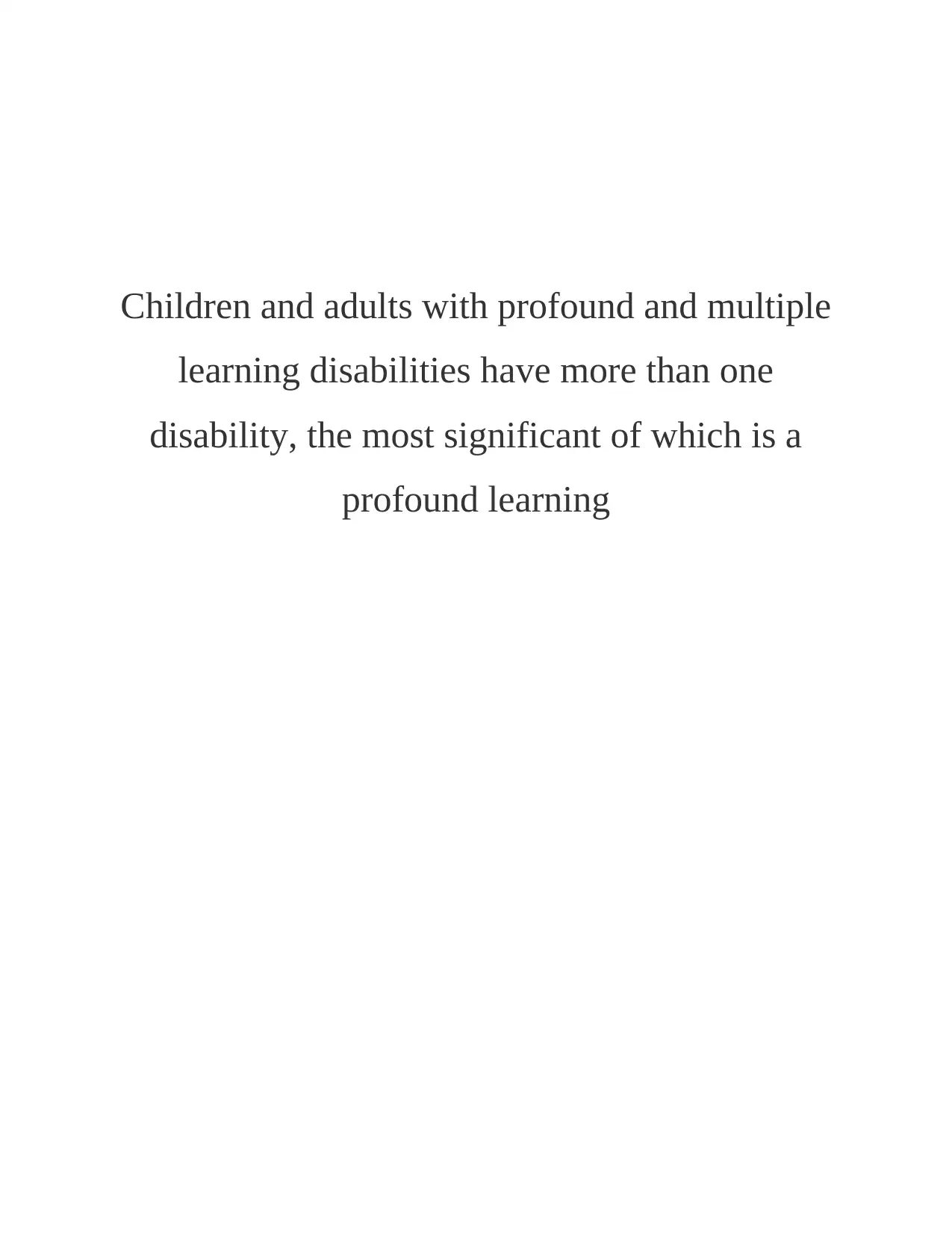
Children and adults with profound and multiple
learning disabilities have more than one
disability, the most significant of which is a
profound learning
learning disabilities have more than one
disability, the most significant of which is a
profound learning
Paraphrase This Document
Need a fresh take? Get an instant paraphrase of this document with our AI Paraphraser
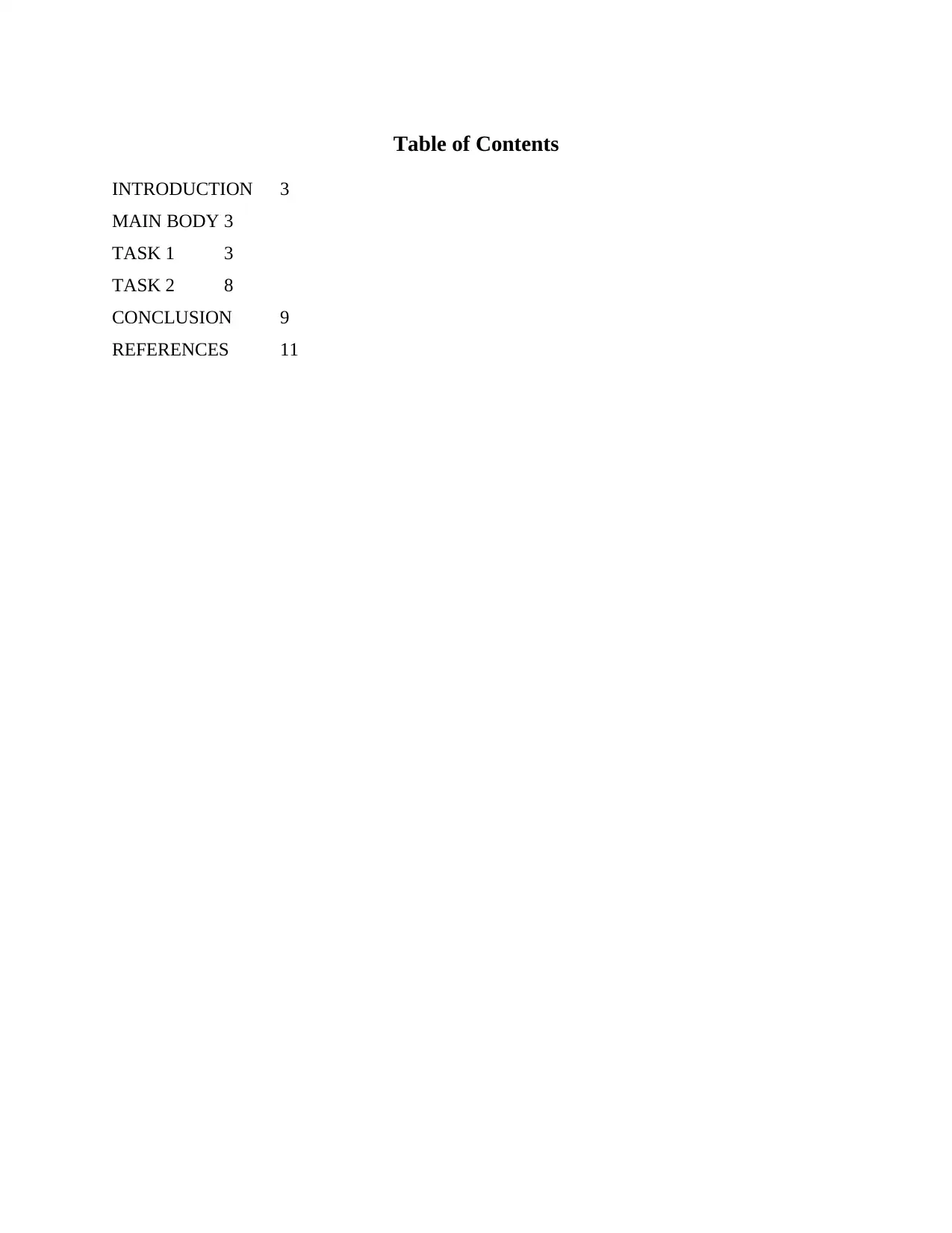
Table of Contents
INTRODUCTION 3
MAIN BODY 3
TASK 1 3
TASK 2 8
CONCLUSION 9
REFERENCES 11
INTRODUCTION 3
MAIN BODY 3
TASK 1 3
TASK 2 8
CONCLUSION 9
REFERENCES 11
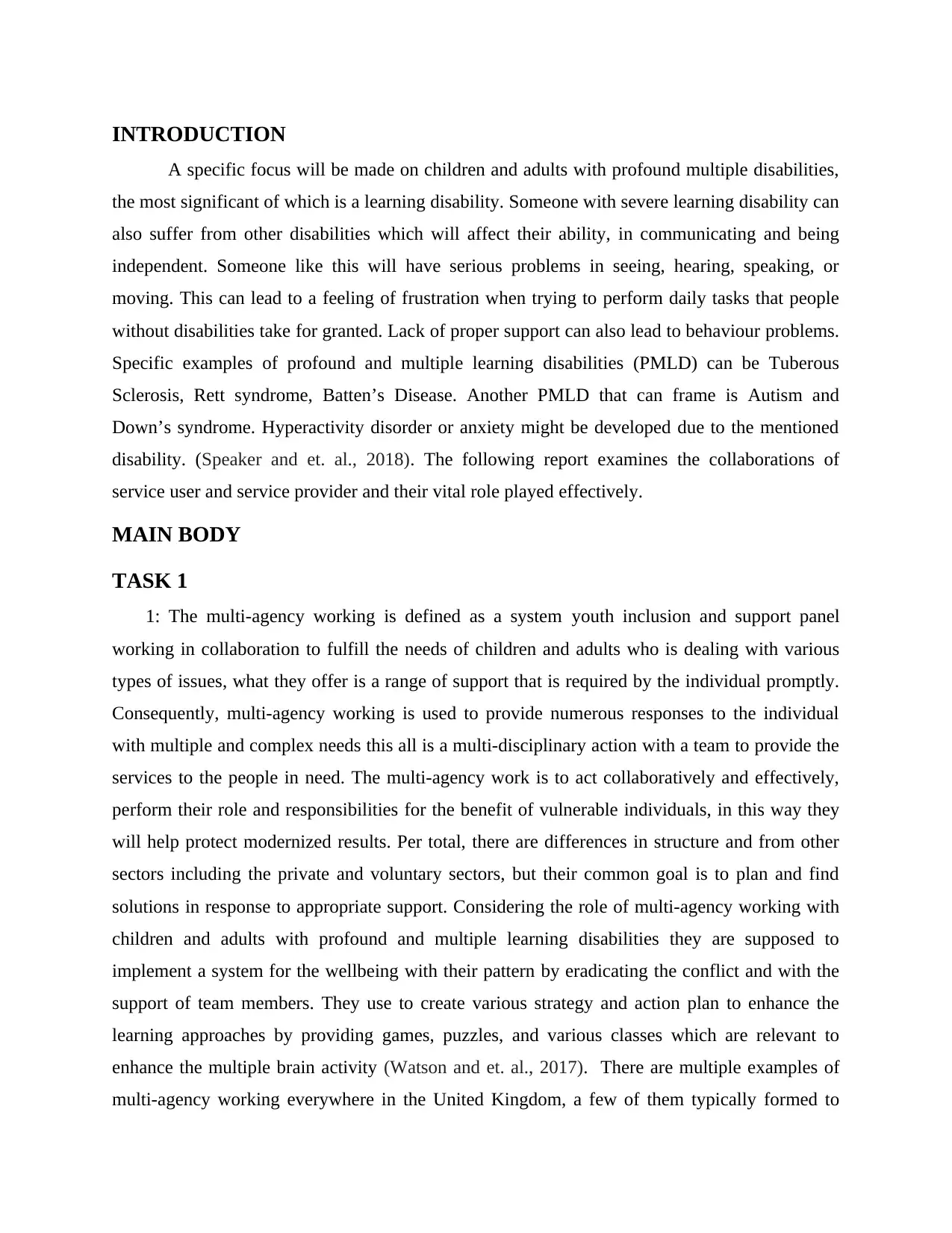
INTRODUCTION
A specific focus will be made on children and adults with profound multiple disabilities,
the most significant of which is a learning disability. Someone with severe learning disability can
also suffer from other disabilities which will affect their ability, in communicating and being
independent. Someone like this will have serious problems in seeing, hearing, speaking, or
moving. This can lead to a feeling of frustration when trying to perform daily tasks that people
without disabilities take for granted. Lack of proper support can also lead to behaviour problems.
Specific examples of profound and multiple learning disabilities (PMLD) can be Tuberous
Sclerosis, Rett syndrome, Batten’s Disease. Another PMLD that can frame is Autism and
Down’s syndrome. Hyperactivity disorder or anxiety might be developed due to the mentioned
disability. (Speaker and et. al., 2018). The following report examines the collaborations of
service user and service provider and their vital role played effectively.
MAIN BODY
TASK 1
1: The multi-agency working is defined as a system youth inclusion and support panel
working in collaboration to fulfill the needs of children and adults who is dealing with various
types of issues, what they offer is a range of support that is required by the individual promptly.
Consequently, multi-agency working is used to provide numerous responses to the individual
with multiple and complex needs this all is a multi-disciplinary action with a team to provide the
services to the people in need. The multi-agency work is to act collaboratively and effectively,
perform their role and responsibilities for the benefit of vulnerable individuals, in this way they
will help protect modernized results. Per total, there are differences in structure and from other
sectors including the private and voluntary sectors, but their common goal is to plan and find
solutions in response to appropriate support. Considering the role of multi-agency working with
children and adults with profound and multiple learning disabilities they are supposed to
implement a system for the wellbeing with their pattern by eradicating the conflict and with the
support of team members. They use to create various strategy and action plan to enhance the
learning approaches by providing games, puzzles, and various classes which are relevant to
enhance the multiple brain activity (Watson and et. al., 2017). There are multiple examples of
multi-agency working everywhere in the United Kingdom, a few of them typically formed to
A specific focus will be made on children and adults with profound multiple disabilities,
the most significant of which is a learning disability. Someone with severe learning disability can
also suffer from other disabilities which will affect their ability, in communicating and being
independent. Someone like this will have serious problems in seeing, hearing, speaking, or
moving. This can lead to a feeling of frustration when trying to perform daily tasks that people
without disabilities take for granted. Lack of proper support can also lead to behaviour problems.
Specific examples of profound and multiple learning disabilities (PMLD) can be Tuberous
Sclerosis, Rett syndrome, Batten’s Disease. Another PMLD that can frame is Autism and
Down’s syndrome. Hyperactivity disorder or anxiety might be developed due to the mentioned
disability. (Speaker and et. al., 2018). The following report examines the collaborations of
service user and service provider and their vital role played effectively.
MAIN BODY
TASK 1
1: The multi-agency working is defined as a system youth inclusion and support panel
working in collaboration to fulfill the needs of children and adults who is dealing with various
types of issues, what they offer is a range of support that is required by the individual promptly.
Consequently, multi-agency working is used to provide numerous responses to the individual
with multiple and complex needs this all is a multi-disciplinary action with a team to provide the
services to the people in need. The multi-agency work is to act collaboratively and effectively,
perform their role and responsibilities for the benefit of vulnerable individuals, in this way they
will help protect modernized results. Per total, there are differences in structure and from other
sectors including the private and voluntary sectors, but their common goal is to plan and find
solutions in response to appropriate support. Considering the role of multi-agency working with
children and adults with profound and multiple learning disabilities they are supposed to
implement a system for the wellbeing with their pattern by eradicating the conflict and with the
support of team members. They use to create various strategy and action plan to enhance the
learning approaches by providing games, puzzles, and various classes which are relevant to
enhance the multiple brain activity (Watson and et. al., 2017). There are multiple examples of
multi-agency working everywhere in the United Kingdom, a few of them typically formed to
⊘ This is a preview!⊘
Do you want full access?
Subscribe today to unlock all pages.

Trusted by 1+ million students worldwide
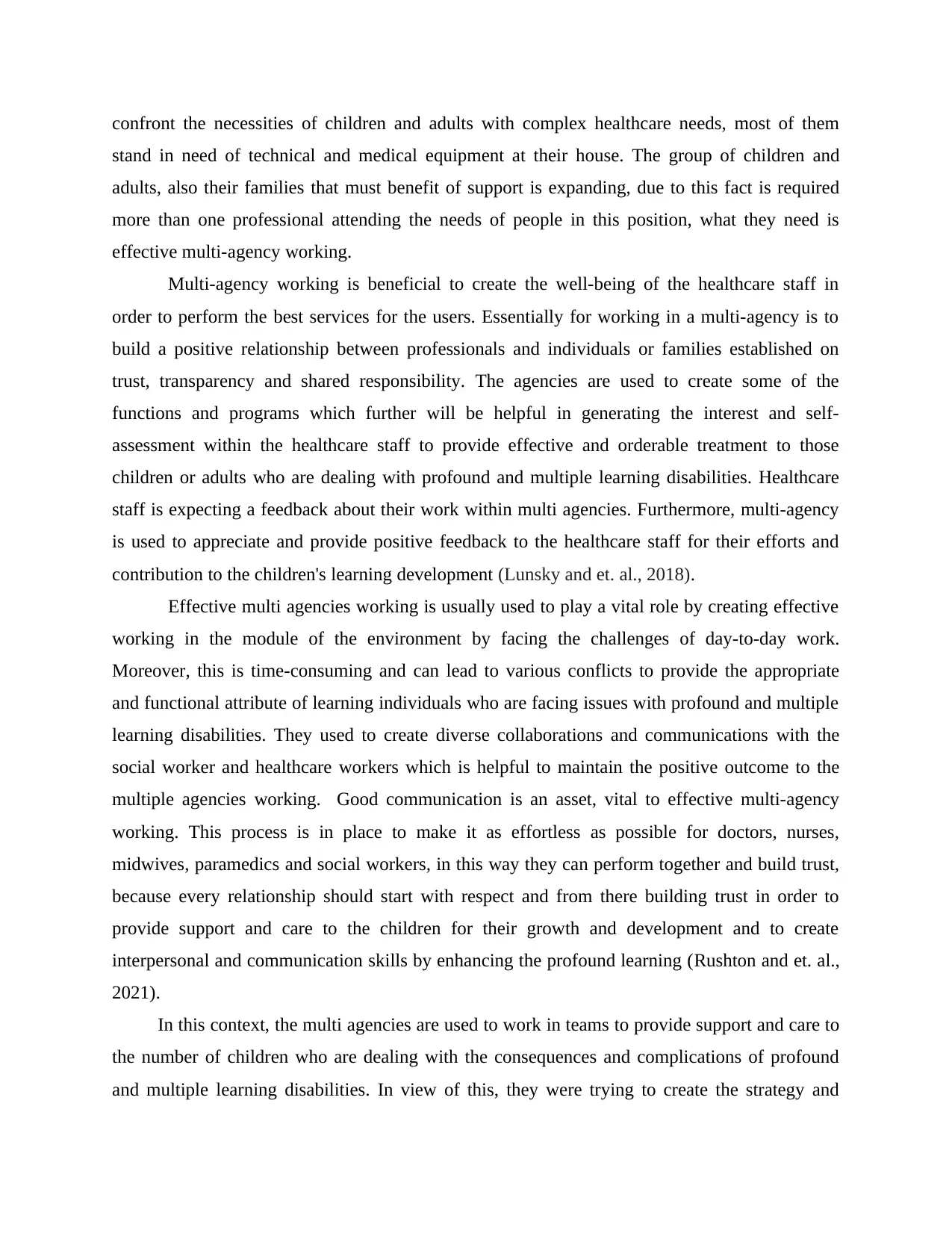
confront the necessities of children and adults with complex healthcare needs, most of them
stand in need of technical and medical equipment at their house. The group of children and
adults, also their families that must benefit of support is expanding, due to this fact is required
more than one professional attending the needs of people in this position, what they need is
effective multi-agency working.
Multi-agency working is beneficial to create the well-being of the healthcare staff in
order to perform the best services for the users. Essentially for working in a multi-agency is to
build a positive relationship between professionals and individuals or families established on
trust, transparency and shared responsibility. The agencies are used to create some of the
functions and programs which further will be helpful in generating the interest and self-
assessment within the healthcare staff to provide effective and orderable treatment to those
children or adults who are dealing with profound and multiple learning disabilities. Healthcare
staff is expecting a feedback about their work within multi agencies. Furthermore, multi-agency
is used to appreciate and provide positive feedback to the healthcare staff for their efforts and
contribution to the children's learning development (Lunsky and et. al., 2018).
Effective multi agencies working is usually used to play a vital role by creating effective
working in the module of the environment by facing the challenges of day-to-day work.
Moreover, this is time-consuming and can lead to various conflicts to provide the appropriate
and functional attribute of learning individuals who are facing issues with profound and multiple
learning disabilities. They used to create diverse collaborations and communications with the
social worker and healthcare workers which is helpful to maintain the positive outcome to the
multiple agencies working. Good communication is an asset, vital to effective multi-agency
working. This process is in place to make it as effortless as possible for doctors, nurses,
midwives, paramedics and social workers, in this way they can perform together and build trust,
because every relationship should start with respect and from there building trust in order to
provide support and care to the children for their growth and development and to create
interpersonal and communication skills by enhancing the profound learning (Rushton and et. al.,
2021).
In this context, the multi agencies are used to work in teams to provide support and care to
the number of children who are dealing with the consequences and complications of profound
and multiple learning disabilities. In view of this, they were trying to create the strategy and
stand in need of technical and medical equipment at their house. The group of children and
adults, also their families that must benefit of support is expanding, due to this fact is required
more than one professional attending the needs of people in this position, what they need is
effective multi-agency working.
Multi-agency working is beneficial to create the well-being of the healthcare staff in
order to perform the best services for the users. Essentially for working in a multi-agency is to
build a positive relationship between professionals and individuals or families established on
trust, transparency and shared responsibility. The agencies are used to create some of the
functions and programs which further will be helpful in generating the interest and self-
assessment within the healthcare staff to provide effective and orderable treatment to those
children or adults who are dealing with profound and multiple learning disabilities. Healthcare
staff is expecting a feedback about their work within multi agencies. Furthermore, multi-agency
is used to appreciate and provide positive feedback to the healthcare staff for their efforts and
contribution to the children's learning development (Lunsky and et. al., 2018).
Effective multi agencies working is usually used to play a vital role by creating effective
working in the module of the environment by facing the challenges of day-to-day work.
Moreover, this is time-consuming and can lead to various conflicts to provide the appropriate
and functional attribute of learning individuals who are facing issues with profound and multiple
learning disabilities. They used to create diverse collaborations and communications with the
social worker and healthcare workers which is helpful to maintain the positive outcome to the
multiple agencies working. Good communication is an asset, vital to effective multi-agency
working. This process is in place to make it as effortless as possible for doctors, nurses,
midwives, paramedics and social workers, in this way they can perform together and build trust,
because every relationship should start with respect and from there building trust in order to
provide support and care to the children for their growth and development and to create
interpersonal and communication skills by enhancing the profound learning (Rushton and et. al.,
2021).
In this context, the multi agencies are used to work in teams to provide support and care to
the number of children who are dealing with the consequences and complications of profound
and multiple learning disabilities. In view of this, they were trying to create the strategy and
Paraphrase This Document
Need a fresh take? Get an instant paraphrase of this document with our AI Paraphraser
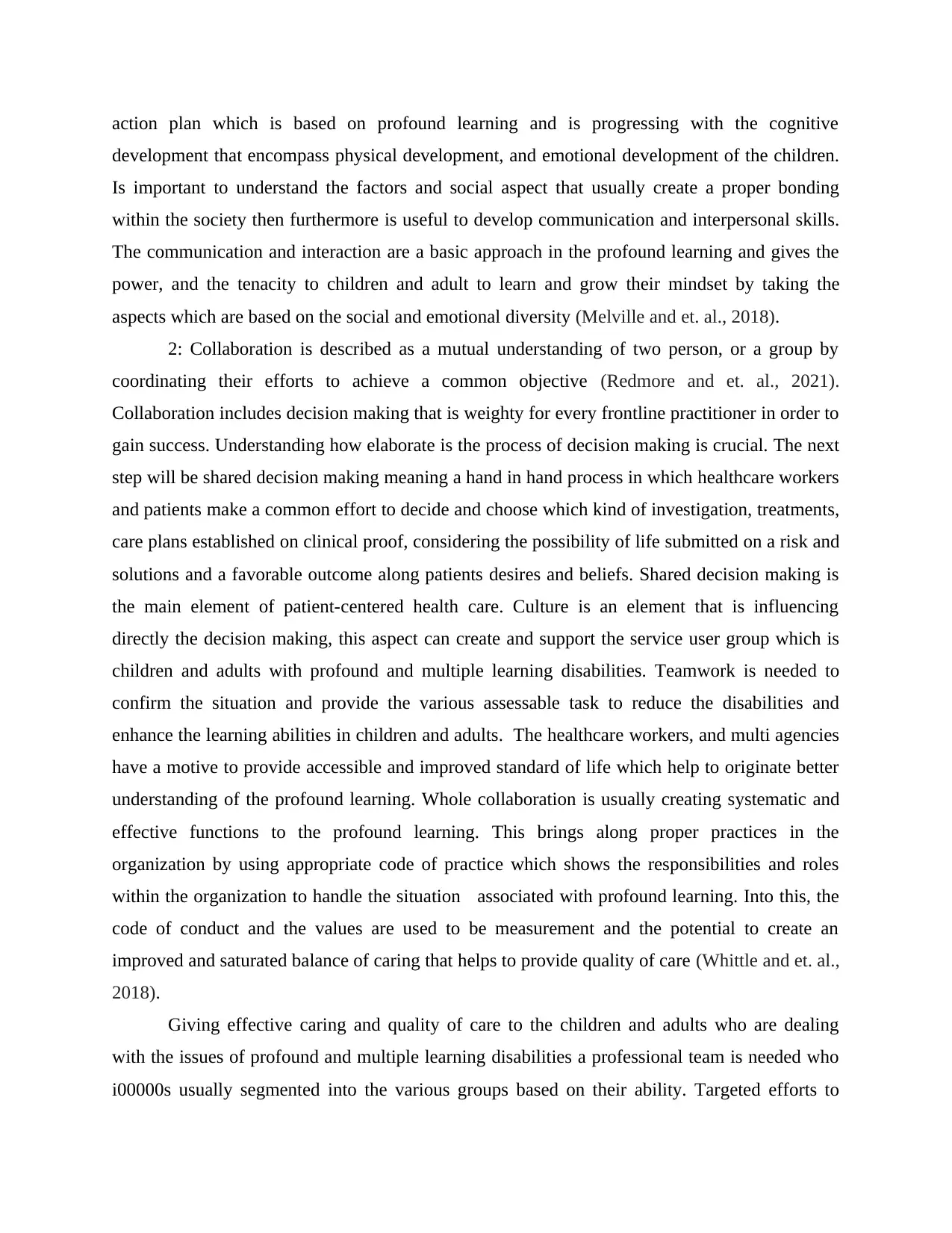
action plan which is based on profound learning and is progressing with the cognitive
development that encompass physical development, and emotional development of the children.
Is important to understand the factors and social aspect that usually create a proper bonding
within the society then furthermore is useful to develop communication and interpersonal skills.
The communication and interaction are a basic approach in the profound learning and gives the
power, and the tenacity to children and adult to learn and grow their mindset by taking the
aspects which are based on the social and emotional diversity (Melville and et. al., 2018).
2: Collaboration is described as a mutual understanding of two person, or a group by
coordinating their efforts to achieve a common objective (Redmore and et. al., 2021).
Collaboration includes decision making that is weighty for every frontline practitioner in order to
gain success. Understanding how elaborate is the process of decision making is crucial. The next
step will be shared decision making meaning a hand in hand process in which healthcare workers
and patients make a common effort to decide and choose which kind of investigation, treatments,
care plans established on clinical proof, considering the possibility of life submitted on a risk and
solutions and a favorable outcome along patients desires and beliefs. Shared decision making is
the main element of patient-centered health care. Culture is an element that is influencing
directly the decision making, this aspect can create and support the service user group which is
children and adults with profound and multiple learning disabilities. Teamwork is needed to
confirm the situation and provide the various assessable task to reduce the disabilities and
enhance the learning abilities in children and adults. The healthcare workers, and multi agencies
have a motive to provide accessible and improved standard of life which help to originate better
understanding of the profound learning. Whole collaboration is usually creating systematic and
effective functions to the profound learning. This brings along proper practices in the
organization by using appropriate code of practice which shows the responsibilities and roles
within the organization to handle the situation associated with profound learning. Into this, the
code of conduct and the values are used to be measurement and the potential to create an
improved and saturated balance of caring that helps to provide quality of care (Whittle and et. al.,
2018).
Giving effective caring and quality of care to the children and adults who are dealing
with the issues of profound and multiple learning disabilities a professional team is needed who
i00000s usually segmented into the various groups based on their ability. Targeted efforts to
development that encompass physical development, and emotional development of the children.
Is important to understand the factors and social aspect that usually create a proper bonding
within the society then furthermore is useful to develop communication and interpersonal skills.
The communication and interaction are a basic approach in the profound learning and gives the
power, and the tenacity to children and adult to learn and grow their mindset by taking the
aspects which are based on the social and emotional diversity (Melville and et. al., 2018).
2: Collaboration is described as a mutual understanding of two person, or a group by
coordinating their efforts to achieve a common objective (Redmore and et. al., 2021).
Collaboration includes decision making that is weighty for every frontline practitioner in order to
gain success. Understanding how elaborate is the process of decision making is crucial. The next
step will be shared decision making meaning a hand in hand process in which healthcare workers
and patients make a common effort to decide and choose which kind of investigation, treatments,
care plans established on clinical proof, considering the possibility of life submitted on a risk and
solutions and a favorable outcome along patients desires and beliefs. Shared decision making is
the main element of patient-centered health care. Culture is an element that is influencing
directly the decision making, this aspect can create and support the service user group which is
children and adults with profound and multiple learning disabilities. Teamwork is needed to
confirm the situation and provide the various assessable task to reduce the disabilities and
enhance the learning abilities in children and adults. The healthcare workers, and multi agencies
have a motive to provide accessible and improved standard of life which help to originate better
understanding of the profound learning. Whole collaboration is usually creating systematic and
effective functions to the profound learning. This brings along proper practices in the
organization by using appropriate code of practice which shows the responsibilities and roles
within the organization to handle the situation associated with profound learning. Into this, the
code of conduct and the values are used to be measurement and the potential to create an
improved and saturated balance of caring that helps to provide quality of care (Whittle and et. al.,
2018).
Giving effective caring and quality of care to the children and adults who are dealing
with the issues of profound and multiple learning disabilities a professional team is needed who
i00000s usually segmented into the various groups based on their ability. Targeted efforts to
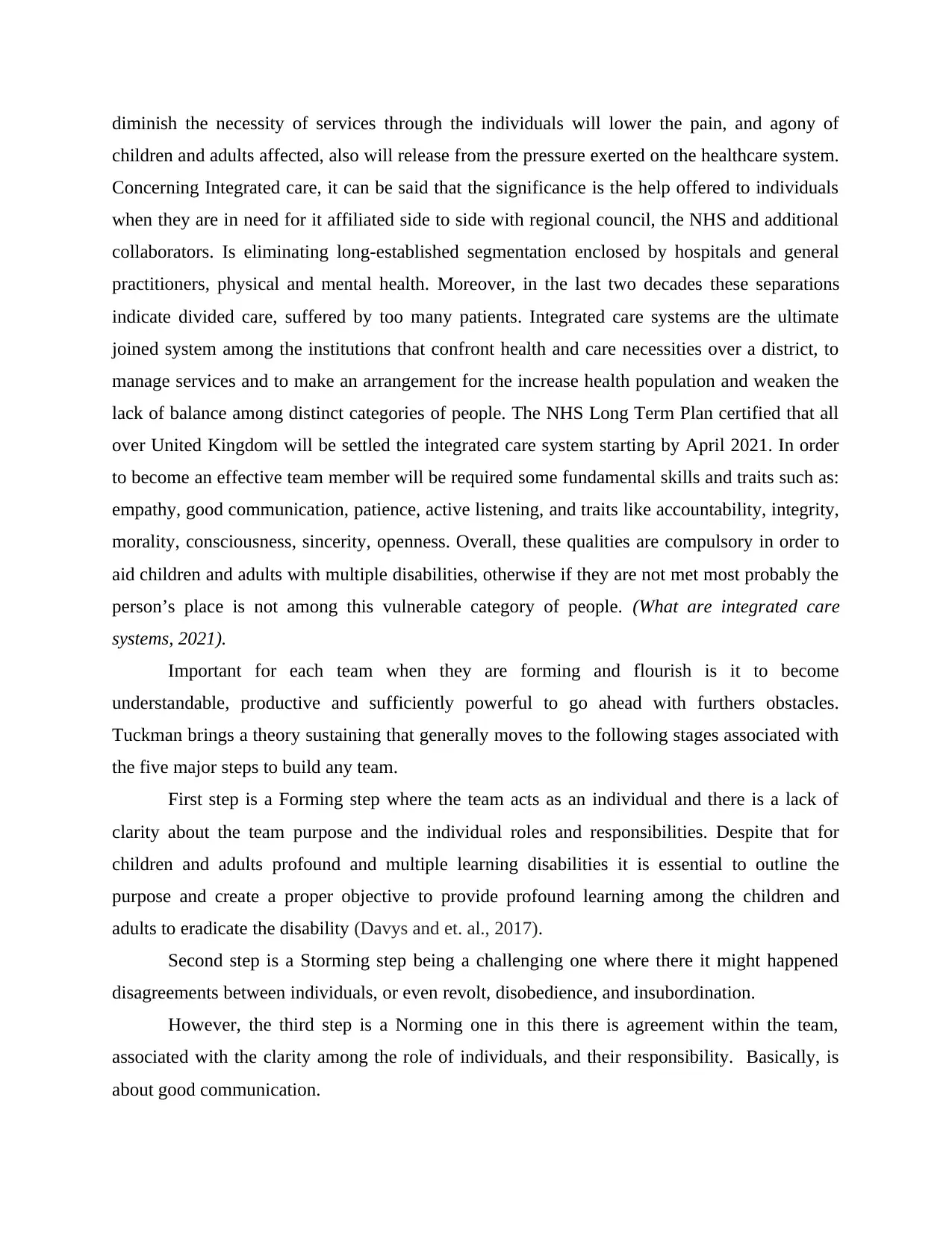
diminish the necessity of services through the individuals will lower the pain, and agony of
children and adults affected, also will release from the pressure exerted on the healthcare system.
Concerning Integrated care, it can be said that the significance is the help offered to individuals
when they are in need for it affiliated side to side with regional council, the NHS and additional
collaborators. Is eliminating long-established segmentation enclosed by hospitals and general
practitioners, physical and mental health. Moreover, in the last two decades these separations
indicate divided care, suffered by too many patients. Integrated care systems are the ultimate
joined system among the institutions that confront health and care necessities over a district, to
manage services and to make an arrangement for the increase health population and weaken the
lack of balance among distinct categories of people. The NHS Long Term Plan certified that all
over United Kingdom will be settled the integrated care system starting by April 2021. In order
to become an effective team member will be required some fundamental skills and traits such as:
empathy, good communication, patience, active listening, and traits like accountability, integrity,
morality, consciousness, sincerity, openness. Overall, these qualities are compulsory in order to
aid children and adults with multiple disabilities, otherwise if they are not met most probably the
person’s place is not among this vulnerable category of people. (What are integrated care
systems, 2021).
Important for each team when they are forming and flourish is it to become
understandable, productive and sufficiently powerful to go ahead with furthers obstacles.
Tuckman brings a theory sustaining that generally moves to the following stages associated with
the five major steps to build any team.
First step is a Forming step where the team acts as an individual and there is a lack of
clarity about the team purpose and the individual roles and responsibilities. Despite that for
children and adults profound and multiple learning disabilities it is essential to outline the
purpose and create a proper objective to provide profound learning among the children and
adults to eradicate the disability (Davys and et. al., 2017).
Second step is a Storming step being a challenging one where there it might happened
disagreements between individuals, or even revolt, disobedience, and insubordination.
However, the third step is a Norming one in this there is agreement within the team,
associated with the clarity among the role of individuals, and their responsibility. Basically, is
about good communication.
children and adults affected, also will release from the pressure exerted on the healthcare system.
Concerning Integrated care, it can be said that the significance is the help offered to individuals
when they are in need for it affiliated side to side with regional council, the NHS and additional
collaborators. Is eliminating long-established segmentation enclosed by hospitals and general
practitioners, physical and mental health. Moreover, in the last two decades these separations
indicate divided care, suffered by too many patients. Integrated care systems are the ultimate
joined system among the institutions that confront health and care necessities over a district, to
manage services and to make an arrangement for the increase health population and weaken the
lack of balance among distinct categories of people. The NHS Long Term Plan certified that all
over United Kingdom will be settled the integrated care system starting by April 2021. In order
to become an effective team member will be required some fundamental skills and traits such as:
empathy, good communication, patience, active listening, and traits like accountability, integrity,
morality, consciousness, sincerity, openness. Overall, these qualities are compulsory in order to
aid children and adults with multiple disabilities, otherwise if they are not met most probably the
person’s place is not among this vulnerable category of people. (What are integrated care
systems, 2021).
Important for each team when they are forming and flourish is it to become
understandable, productive and sufficiently powerful to go ahead with furthers obstacles.
Tuckman brings a theory sustaining that generally moves to the following stages associated with
the five major steps to build any team.
First step is a Forming step where the team acts as an individual and there is a lack of
clarity about the team purpose and the individual roles and responsibilities. Despite that for
children and adults profound and multiple learning disabilities it is essential to outline the
purpose and create a proper objective to provide profound learning among the children and
adults to eradicate the disability (Davys and et. al., 2017).
Second step is a Storming step being a challenging one where there it might happened
disagreements between individuals, or even revolt, disobedience, and insubordination.
However, the third step is a Norming one in this there is agreement within the team,
associated with the clarity among the role of individuals, and their responsibility. Basically, is
about good communication.
⊘ This is a preview!⊘
Do you want full access?
Subscribe today to unlock all pages.

Trusted by 1+ million students worldwide
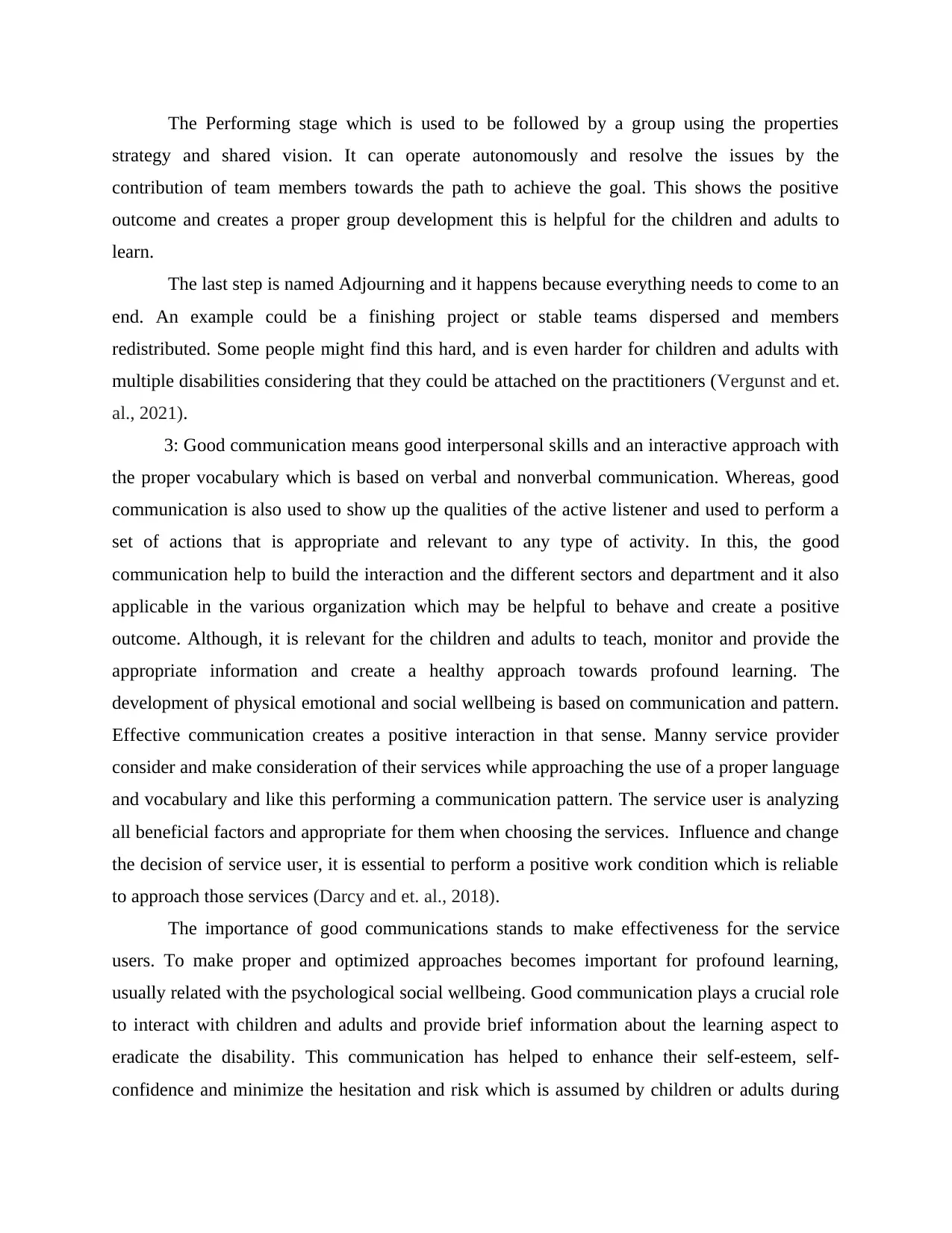
The Performing stage which is used to be followed by a group using the properties
strategy and shared vision. It can operate autonomously and resolve the issues by the
contribution of team members towards the path to achieve the goal. This shows the positive
outcome and creates a proper group development this is helpful for the children and adults to
learn.
The last step is named Adjourning and it happens because everything needs to come to an
end. An example could be a finishing project or stable teams dispersed and members
redistributed. Some people might find this hard, and is even harder for children and adults with
multiple disabilities considering that they could be attached on the practitioners (Vergunst and et.
al., 2021).
3: Good communication means good interpersonal skills and an interactive approach with
the proper vocabulary which is based on verbal and nonverbal communication. Whereas, good
communication is also used to show up the qualities of the active listener and used to perform a
set of actions that is appropriate and relevant to any type of activity. In this, the good
communication help to build the interaction and the different sectors and department and it also
applicable in the various organization which may be helpful to behave and create a positive
outcome. Although, it is relevant for the children and adults to teach, monitor and provide the
appropriate information and create a healthy approach towards profound learning. The
development of physical emotional and social wellbeing is based on communication and pattern.
Effective communication creates a positive interaction in that sense. Manny service provider
consider and make consideration of their services while approaching the use of a proper language
and vocabulary and like this performing a communication pattern. The service user is analyzing
all beneficial factors and appropriate for them when choosing the services. Influence and change
the decision of service user, it is essential to perform a positive work condition which is reliable
to approach those services (Darcy and et. al., 2018).
The importance of good communications stands to make effectiveness for the service
users. To make proper and optimized approaches becomes important for profound learning,
usually related with the psychological social wellbeing. Good communication plays a crucial role
to interact with children and adults and provide brief information about the learning aspect to
eradicate the disability. This communication has helped to enhance their self-esteem, self-
confidence and minimize the hesitation and risk which is assumed by children or adults during
strategy and shared vision. It can operate autonomously and resolve the issues by the
contribution of team members towards the path to achieve the goal. This shows the positive
outcome and creates a proper group development this is helpful for the children and adults to
learn.
The last step is named Adjourning and it happens because everything needs to come to an
end. An example could be a finishing project or stable teams dispersed and members
redistributed. Some people might find this hard, and is even harder for children and adults with
multiple disabilities considering that they could be attached on the practitioners (Vergunst and et.
al., 2021).
3: Good communication means good interpersonal skills and an interactive approach with
the proper vocabulary which is based on verbal and nonverbal communication. Whereas, good
communication is also used to show up the qualities of the active listener and used to perform a
set of actions that is appropriate and relevant to any type of activity. In this, the good
communication help to build the interaction and the different sectors and department and it also
applicable in the various organization which may be helpful to behave and create a positive
outcome. Although, it is relevant for the children and adults to teach, monitor and provide the
appropriate information and create a healthy approach towards profound learning. The
development of physical emotional and social wellbeing is based on communication and pattern.
Effective communication creates a positive interaction in that sense. Manny service provider
consider and make consideration of their services while approaching the use of a proper language
and vocabulary and like this performing a communication pattern. The service user is analyzing
all beneficial factors and appropriate for them when choosing the services. Influence and change
the decision of service user, it is essential to perform a positive work condition which is reliable
to approach those services (Darcy and et. al., 2018).
The importance of good communications stands to make effectiveness for the service
users. To make proper and optimized approaches becomes important for profound learning,
usually related with the psychological social wellbeing. Good communication plays a crucial role
to interact with children and adults and provide brief information about the learning aspect to
eradicate the disability. This communication has helped to enhance their self-esteem, self-
confidence and minimize the hesitation and risk which is assumed by children or adults during
Paraphrase This Document
Need a fresh take? Get an instant paraphrase of this document with our AI Paraphraser
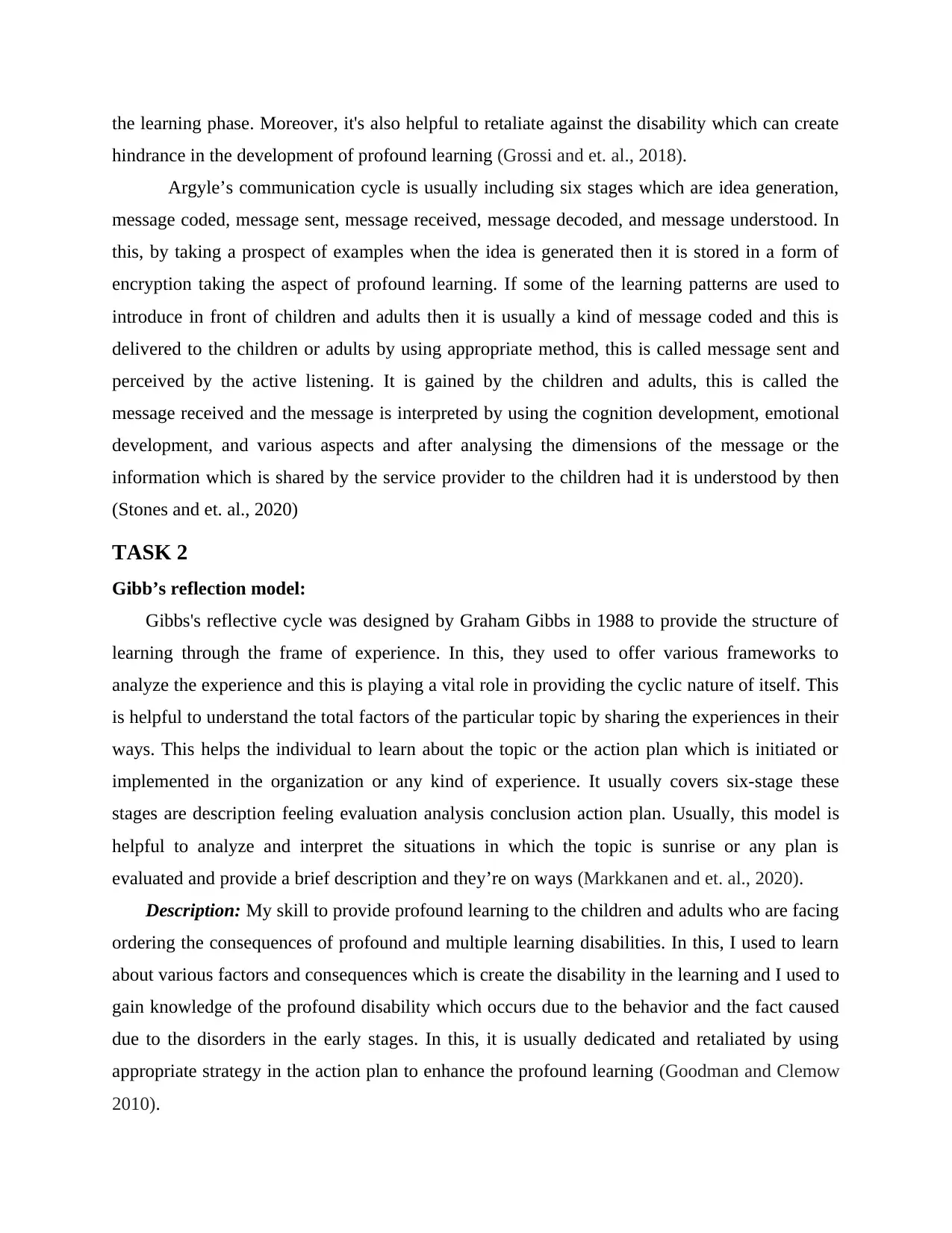
the learning phase. Moreover, it's also helpful to retaliate against the disability which can create
hindrance in the development of profound learning (Grossi and et. al., 2018).
Argyle’s communication cycle is usually including six stages which are idea generation,
message coded, message sent, message received, message decoded, and message understood. In
this, by taking a prospect of examples when the idea is generated then it is stored in a form of
encryption taking the aspect of profound learning. If some of the learning patterns are used to
introduce in front of children and adults then it is usually a kind of message coded and this is
delivered to the children or adults by using appropriate method, this is called message sent and
perceived by the active listening. It is gained by the children and adults, this is called the
message received and the message is interpreted by using the cognition development, emotional
development, and various aspects and after analysing the dimensions of the message or the
information which is shared by the service provider to the children had it is understood by then
(Stones and et. al., 2020)
TASK 2
Gibb’s reflection model:
Gibbs's reflective cycle was designed by Graham Gibbs in 1988 to provide the structure of
learning through the frame of experience. In this, they used to offer various frameworks to
analyze the experience and this is playing a vital role in providing the cyclic nature of itself. This
is helpful to understand the total factors of the particular topic by sharing the experiences in their
ways. This helps the individual to learn about the topic or the action plan which is initiated or
implemented in the organization or any kind of experience. It usually covers six-stage these
stages are description feeling evaluation analysis conclusion action plan. Usually, this model is
helpful to analyze and interpret the situations in which the topic is sunrise or any plan is
evaluated and provide a brief description and they’re on ways (Markkanen and et. al., 2020).
Description: My skill to provide profound learning to the children and adults who are facing
ordering the consequences of profound and multiple learning disabilities. In this, I used to learn
about various factors and consequences which is create the disability in the learning and I used to
gain knowledge of the profound disability which occurs due to the behavior and the fact caused
due to the disorders in the early stages. In this, it is usually dedicated and retaliated by using
appropriate strategy in the action plan to enhance the profound learning (Goodman and Clemow
2010).
hindrance in the development of profound learning (Grossi and et. al., 2018).
Argyle’s communication cycle is usually including six stages which are idea generation,
message coded, message sent, message received, message decoded, and message understood. In
this, by taking a prospect of examples when the idea is generated then it is stored in a form of
encryption taking the aspect of profound learning. If some of the learning patterns are used to
introduce in front of children and adults then it is usually a kind of message coded and this is
delivered to the children or adults by using appropriate method, this is called message sent and
perceived by the active listening. It is gained by the children and adults, this is called the
message received and the message is interpreted by using the cognition development, emotional
development, and various aspects and after analysing the dimensions of the message or the
information which is shared by the service provider to the children had it is understood by then
(Stones and et. al., 2020)
TASK 2
Gibb’s reflection model:
Gibbs's reflective cycle was designed by Graham Gibbs in 1988 to provide the structure of
learning through the frame of experience. In this, they used to offer various frameworks to
analyze the experience and this is playing a vital role in providing the cyclic nature of itself. This
is helpful to understand the total factors of the particular topic by sharing the experiences in their
ways. This helps the individual to learn about the topic or the action plan which is initiated or
implemented in the organization or any kind of experience. It usually covers six-stage these
stages are description feeling evaluation analysis conclusion action plan. Usually, this model is
helpful to analyze and interpret the situations in which the topic is sunrise or any plan is
evaluated and provide a brief description and they’re on ways (Markkanen and et. al., 2020).
Description: My skill to provide profound learning to the children and adults who are facing
ordering the consequences of profound and multiple learning disabilities. In this, I used to learn
about various factors and consequences which is create the disability in the learning and I used to
gain knowledge of the profound disability which occurs due to the behavior and the fact caused
due to the disorders in the early stages. In this, it is usually dedicated and retaliated by using
appropriate strategy in the action plan to enhance the profound learning (Goodman and Clemow
2010).
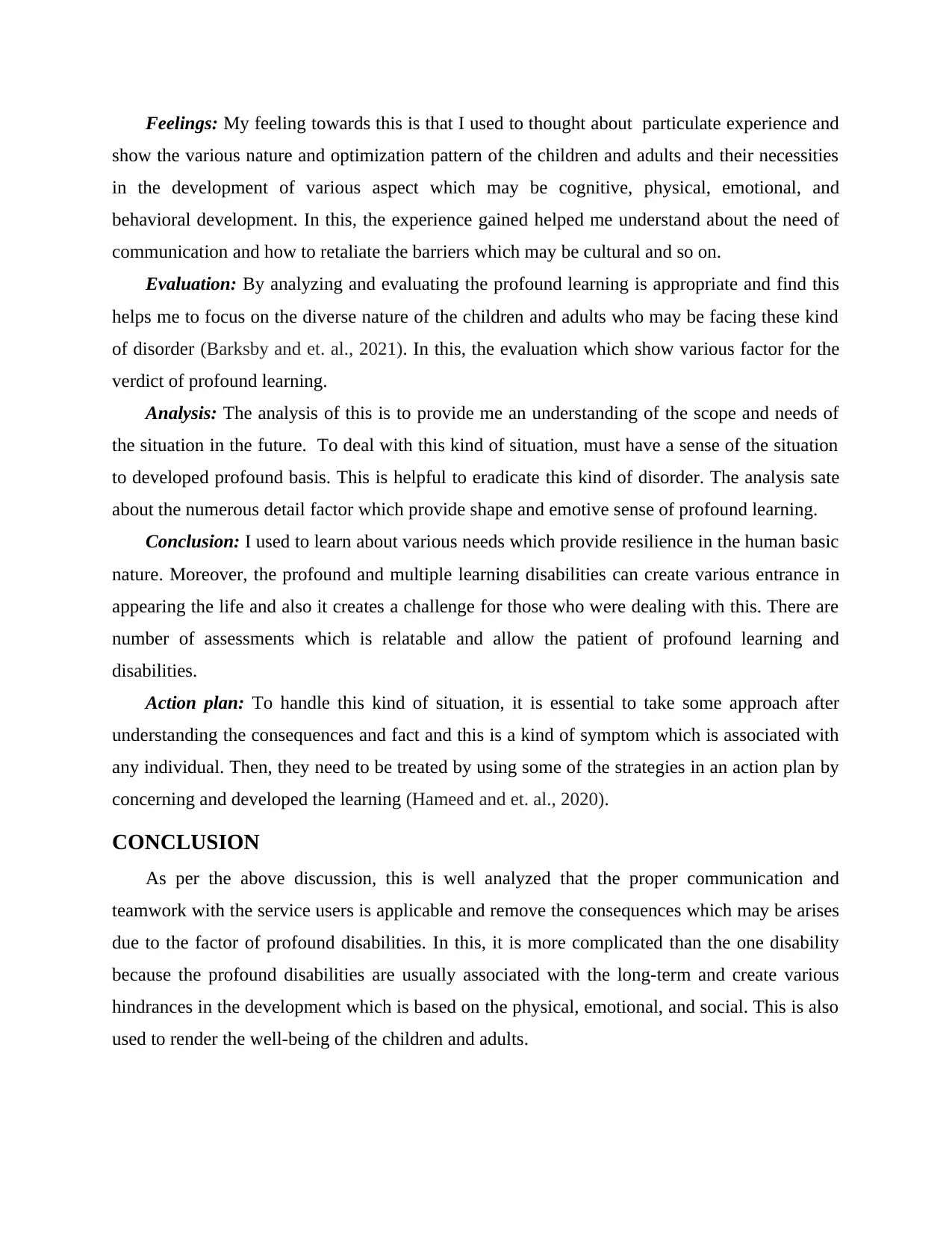
Feelings: My feeling towards this is that I used to thought about particulate experience and
show the various nature and optimization pattern of the children and adults and their necessities
in the development of various aspect which may be cognitive, physical, emotional, and
behavioral development. In this, the experience gained helped me understand about the need of
communication and how to retaliate the barriers which may be cultural and so on.
Evaluation: By analyzing and evaluating the profound learning is appropriate and find this
helps me to focus on the diverse nature of the children and adults who may be facing these kind
of disorder (Barksby and et. al., 2021). In this, the evaluation which show various factor for the
verdict of profound learning.
Analysis: The analysis of this is to provide me an understanding of the scope and needs of
the situation in the future. To deal with this kind of situation, must have a sense of the situation
to developed profound basis. This is helpful to eradicate this kind of disorder. The analysis sate
about the numerous detail factor which provide shape and emotive sense of profound learning.
Conclusion: I used to learn about various needs which provide resilience in the human basic
nature. Moreover, the profound and multiple learning disabilities can create various entrance in
appearing the life and also it creates a challenge for those who were dealing with this. There are
number of assessments which is relatable and allow the patient of profound learning and
disabilities.
Action plan: To handle this kind of situation, it is essential to take some approach after
understanding the consequences and fact and this is a kind of symptom which is associated with
any individual. Then, they need to be treated by using some of the strategies in an action plan by
concerning and developed the learning (Hameed and et. al., 2020).
CONCLUSION
As per the above discussion, this is well analyzed that the proper communication and
teamwork with the service users is applicable and remove the consequences which may be arises
due to the factor of profound disabilities. In this, it is more complicated than the one disability
because the profound disabilities are usually associated with the long-term and create various
hindrances in the development which is based on the physical, emotional, and social. This is also
used to render the well-being of the children and adults.
show the various nature and optimization pattern of the children and adults and their necessities
in the development of various aspect which may be cognitive, physical, emotional, and
behavioral development. In this, the experience gained helped me understand about the need of
communication and how to retaliate the barriers which may be cultural and so on.
Evaluation: By analyzing and evaluating the profound learning is appropriate and find this
helps me to focus on the diverse nature of the children and adults who may be facing these kind
of disorder (Barksby and et. al., 2021). In this, the evaluation which show various factor for the
verdict of profound learning.
Analysis: The analysis of this is to provide me an understanding of the scope and needs of
the situation in the future. To deal with this kind of situation, must have a sense of the situation
to developed profound basis. This is helpful to eradicate this kind of disorder. The analysis sate
about the numerous detail factor which provide shape and emotive sense of profound learning.
Conclusion: I used to learn about various needs which provide resilience in the human basic
nature. Moreover, the profound and multiple learning disabilities can create various entrance in
appearing the life and also it creates a challenge for those who were dealing with this. There are
number of assessments which is relatable and allow the patient of profound learning and
disabilities.
Action plan: To handle this kind of situation, it is essential to take some approach after
understanding the consequences and fact and this is a kind of symptom which is associated with
any individual. Then, they need to be treated by using some of the strategies in an action plan by
concerning and developed the learning (Hameed and et. al., 2020).
CONCLUSION
As per the above discussion, this is well analyzed that the proper communication and
teamwork with the service users is applicable and remove the consequences which may be arises
due to the factor of profound disabilities. In this, it is more complicated than the one disability
because the profound disabilities are usually associated with the long-term and create various
hindrances in the development which is based on the physical, emotional, and social. This is also
used to render the well-being of the children and adults.
⊘ This is a preview!⊘
Do you want full access?
Subscribe today to unlock all pages.

Trusted by 1+ million students worldwide
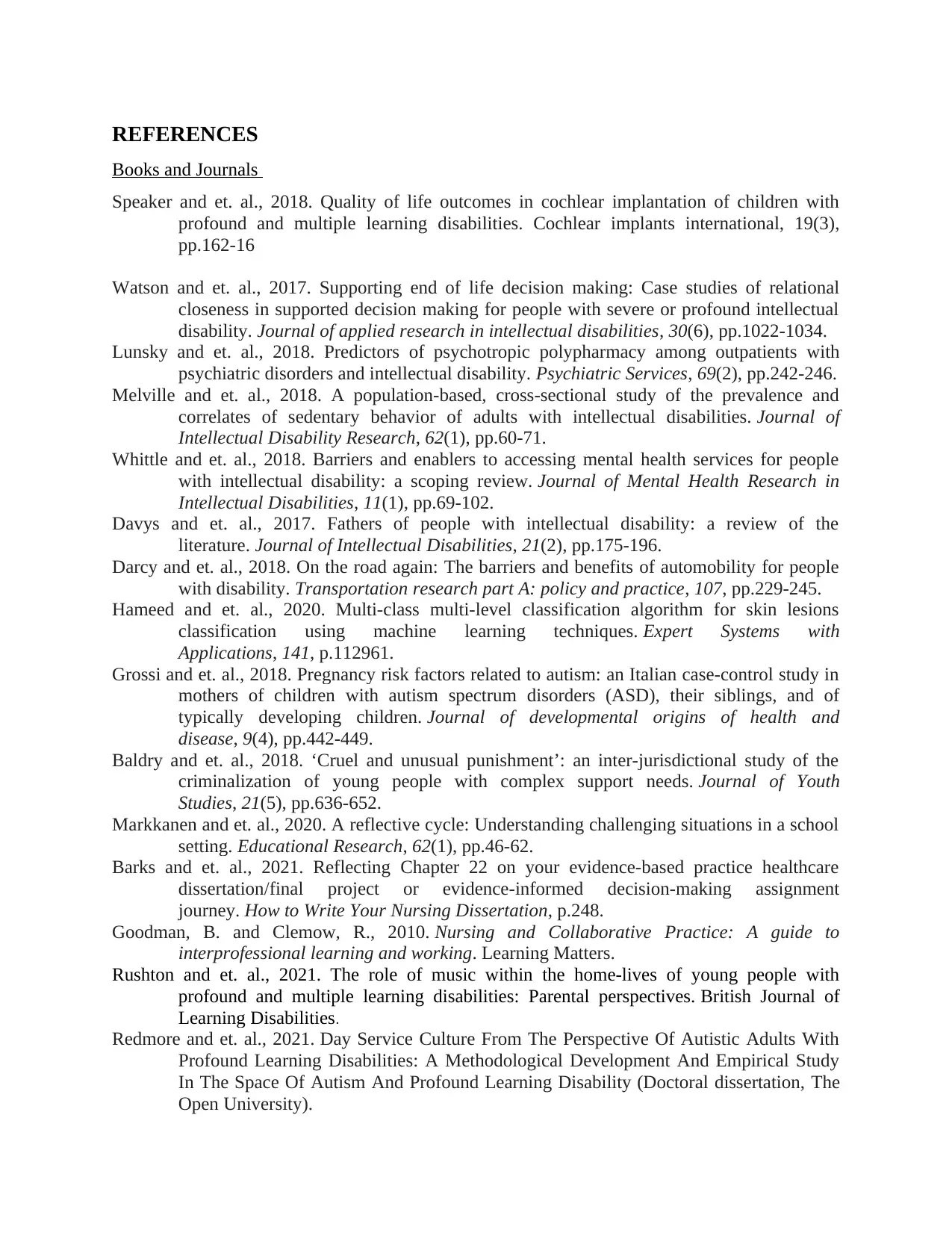
REFERENCES
Books and Journals
Speaker and et. al., 2018. Quality of life outcomes in cochlear implantation of children with
profound and multiple learning disabilities. Cochlear implants international, 19(3),
pp.162-16
Watson and et. al., 2017. Supporting end of life decision making: Case studies of relational
closeness in supported decision making for people with severe or profound intellectual
disability. Journal of applied research in intellectual disabilities, 30(6), pp.1022-1034.
Lunsky and et. al., 2018. Predictors of psychotropic polypharmacy among outpatients with
psychiatric disorders and intellectual disability. Psychiatric Services, 69(2), pp.242-246.
Melville and et. al., 2018. A population‐based, cross‐sectional study of the prevalence and
correlates of sedentary behavior of adults with intellectual disabilities. Journal of
Intellectual Disability Research, 62(1), pp.60-71.
Whittle and et. al., 2018. Barriers and enablers to accessing mental health services for people
with intellectual disability: a scoping review. Journal of Mental Health Research in
Intellectual Disabilities, 11(1), pp.69-102.
Davys and et. al., 2017. Fathers of people with intellectual disability: a review of the
literature. Journal of Intellectual Disabilities, 21(2), pp.175-196.
Darcy and et. al., 2018. On the road again: The barriers and benefits of automobility for people
with disability. Transportation research part A: policy and practice, 107, pp.229-245.
Hameed and et. al., 2020. Multi-class multi-level classification algorithm for skin lesions
classification using machine learning techniques. Expert Systems with
Applications, 141, p.112961.
Grossi and et. al., 2018. Pregnancy risk factors related to autism: an Italian case-control study in
mothers of children with autism spectrum disorders (ASD), their siblings, and of
typically developing children. Journal of developmental origins of health and
disease, 9(4), pp.442-449.
Baldry and et. al., 2018. ‘Cruel and unusual punishment’: an inter-jurisdictional study of the
criminalization of young people with complex support needs. Journal of Youth
Studies, 21(5), pp.636-652.
Markkanen and et. al., 2020. A reflective cycle: Understanding challenging situations in a school
setting. Educational Research, 62(1), pp.46-62.
Barks and et. al., 2021. Reflecting Chapter 22 on your evidence-based practice healthcare
dissertation/final project or evidence-informed decision-making assignment
journey. How to Write Your Nursing Dissertation, p.248.
Goodman, B. and Clemow, R., 2010. Nursing and Collaborative Practice: A guide to
interprofessional learning and working. Learning Matters.
Rushton and et. al., 2021. The role of music within the home‐lives of young people with
profound and multiple learning disabilities: Parental perspectives. British Journal of
Learning Disabilities.
Redmore and et. al., 2021. Day Service Culture From The Perspective Of Autistic Adults With
Profound Learning Disabilities: A Methodological Development And Empirical Study
In The Space Of Autism And Profound Learning Disability (Doctoral dissertation, The
Open University).
Books and Journals
Speaker and et. al., 2018. Quality of life outcomes in cochlear implantation of children with
profound and multiple learning disabilities. Cochlear implants international, 19(3),
pp.162-16
Watson and et. al., 2017. Supporting end of life decision making: Case studies of relational
closeness in supported decision making for people with severe or profound intellectual
disability. Journal of applied research in intellectual disabilities, 30(6), pp.1022-1034.
Lunsky and et. al., 2018. Predictors of psychotropic polypharmacy among outpatients with
psychiatric disorders and intellectual disability. Psychiatric Services, 69(2), pp.242-246.
Melville and et. al., 2018. A population‐based, cross‐sectional study of the prevalence and
correlates of sedentary behavior of adults with intellectual disabilities. Journal of
Intellectual Disability Research, 62(1), pp.60-71.
Whittle and et. al., 2018. Barriers and enablers to accessing mental health services for people
with intellectual disability: a scoping review. Journal of Mental Health Research in
Intellectual Disabilities, 11(1), pp.69-102.
Davys and et. al., 2017. Fathers of people with intellectual disability: a review of the
literature. Journal of Intellectual Disabilities, 21(2), pp.175-196.
Darcy and et. al., 2018. On the road again: The barriers and benefits of automobility for people
with disability. Transportation research part A: policy and practice, 107, pp.229-245.
Hameed and et. al., 2020. Multi-class multi-level classification algorithm for skin lesions
classification using machine learning techniques. Expert Systems with
Applications, 141, p.112961.
Grossi and et. al., 2018. Pregnancy risk factors related to autism: an Italian case-control study in
mothers of children with autism spectrum disorders (ASD), their siblings, and of
typically developing children. Journal of developmental origins of health and
disease, 9(4), pp.442-449.
Baldry and et. al., 2018. ‘Cruel and unusual punishment’: an inter-jurisdictional study of the
criminalization of young people with complex support needs. Journal of Youth
Studies, 21(5), pp.636-652.
Markkanen and et. al., 2020. A reflective cycle: Understanding challenging situations in a school
setting. Educational Research, 62(1), pp.46-62.
Barks and et. al., 2021. Reflecting Chapter 22 on your evidence-based practice healthcare
dissertation/final project or evidence-informed decision-making assignment
journey. How to Write Your Nursing Dissertation, p.248.
Goodman, B. and Clemow, R., 2010. Nursing and Collaborative Practice: A guide to
interprofessional learning and working. Learning Matters.
Rushton and et. al., 2021. The role of music within the home‐lives of young people with
profound and multiple learning disabilities: Parental perspectives. British Journal of
Learning Disabilities.
Redmore and et. al., 2021. Day Service Culture From The Perspective Of Autistic Adults With
Profound Learning Disabilities: A Methodological Development And Empirical Study
In The Space Of Autism And Profound Learning Disability (Doctoral dissertation, The
Open University).
Paraphrase This Document
Need a fresh take? Get an instant paraphrase of this document with our AI Paraphraser
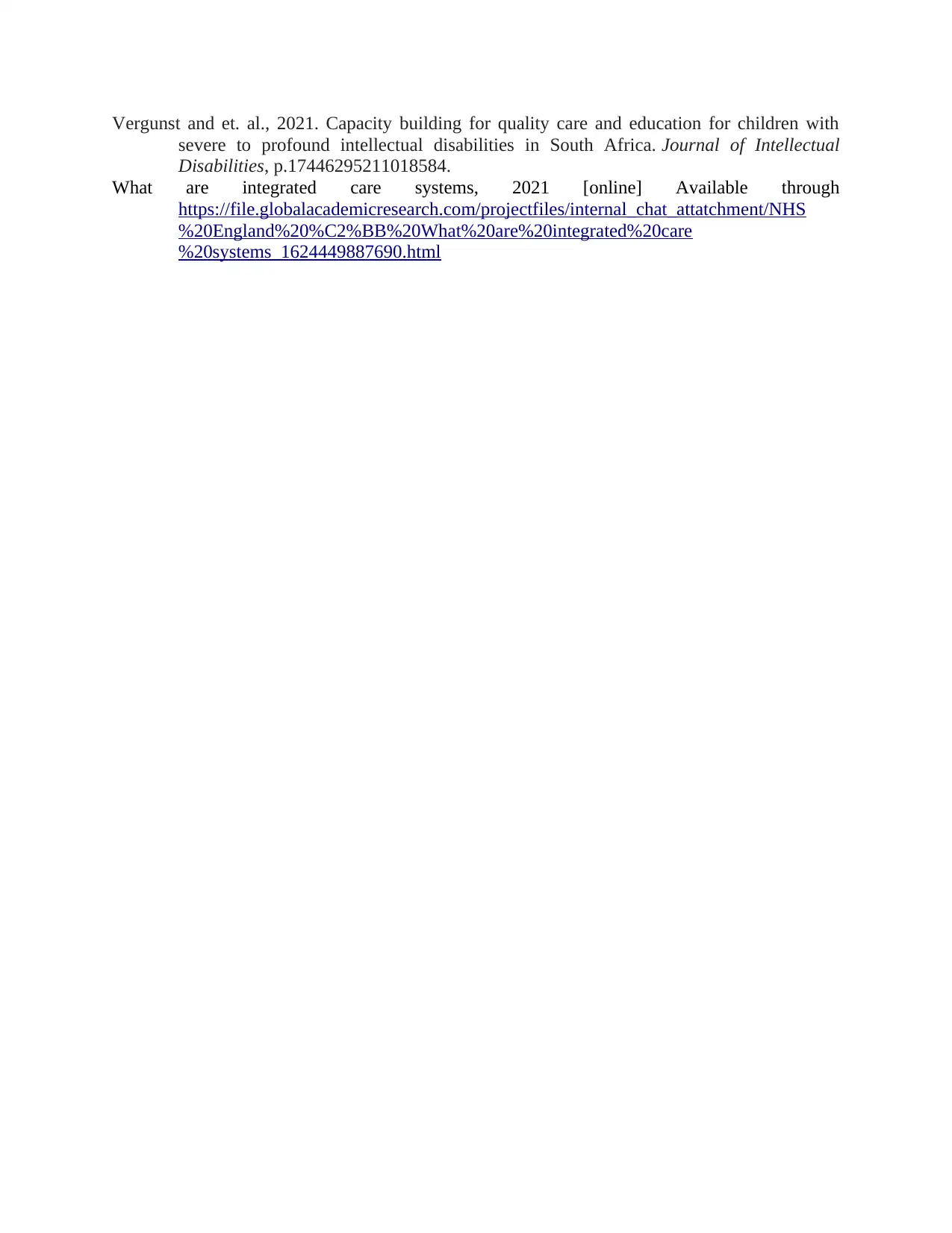
Vergunst and et. al., 2021. Capacity building for quality care and education for children with
severe to profound intellectual disabilities in South Africa. Journal of Intellectual
Disabilities, p.17446295211018584.
What are integrated care systems, 2021 [online] Available through
https://file.globalacademicresearch.com/projectfiles/internal_chat_attatchment/NHS
%20England%20%C2%BB%20What%20are%20integrated%20care
%20systems_1624449887690.html
severe to profound intellectual disabilities in South Africa. Journal of Intellectual
Disabilities, p.17446295211018584.
What are integrated care systems, 2021 [online] Available through
https://file.globalacademicresearch.com/projectfiles/internal_chat_attatchment/NHS
%20England%20%C2%BB%20What%20are%20integrated%20care
%20systems_1624449887690.html
1 out of 11
Related Documents
Your All-in-One AI-Powered Toolkit for Academic Success.
+13062052269
info@desklib.com
Available 24*7 on WhatsApp / Email
![[object Object]](/_next/static/media/star-bottom.7253800d.svg)
Unlock your academic potential
Copyright © 2020–2025 A2Z Services. All Rights Reserved. Developed and managed by ZUCOL.
![HRM4005: Communication and Collaboration Essay - [University Name]](/_next/image/?url=https%3A%2F%2Fdesklib.com%2Fmedia%2Fimages%2Fts%2F865188ba2d07489a8bee110941795025.jpg&w=256&q=75)



